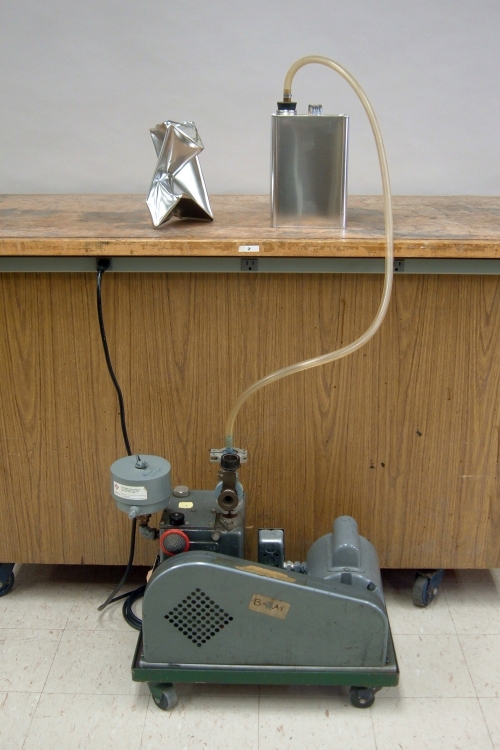

Evacuating the air from a metal can (right) causes it to collapse under the pressure of the atmosphere (left).
A one-gallon steel “F”-style can is connected to the vacuum pump. It is filled with air, and both the air inside it and the air outside it are at the same pressure – atmospheric pressure. At sea level, the average atmospheric pressure is 101,325 pascals (1 pascal = 1 N/m2), which is also equal to 760 torr (1 torr = 1 mm Hg) or 14.7 psi.
The dimensions of the can are approximately 6-5/8″ × 4-3/16″ × 9-7/16″ (0.1683 m × 0.10636 m × 0.23971 m), which means that its surface area is roughly 260 square inches (0.168 square meters). The force applied by the atmosphere over this area is 14.7 psi × 260 square inches, or 3,820 pounds (or 101,325 Pa × 0.168 m2 = 1.70 × 104 N). The air inside the can, which is at the same pressure as the air outside the can, balances this force, so there is no net force on the walls of the can. (Yes, they are being squeezed by this pressure, but they are not being pushed inward or outward.) Note that the can, whether it is full or being evacuated, is not accelerated in any direction. Whatever force the atmosphere exerts on any portion of the can, it exerts the same force over the corresponding area on the opposite side of the can. In agreement with Newton’s third law, the total force along the line between the two opposite portions of the can is equal to the force exerted on either portion. (See demonstration 12.39 -- Tension in rope. Here, the force is tensive instead of compressive, but the result is similar.) Strictly speaking, then, the total force on the can is not 3,820 pounds (1.70 × 104 N), but 1,910 pounds (8.5 × 103 N).
When you turn on the vacuum pump, it evacuates the can, which lowers the pressure inside the can. The pump quickly removes most of the air inside the can, so that the difference in pressure between the outside and the inside of the can is essentially one atmosphere, and, as noted above, the can has a total force of 1,910 pounds, or 8.5 × 103 N, pressing on the outside, with nothing balancing it on the inside. The can thus collapses, as did the one shown at left in the photograph.